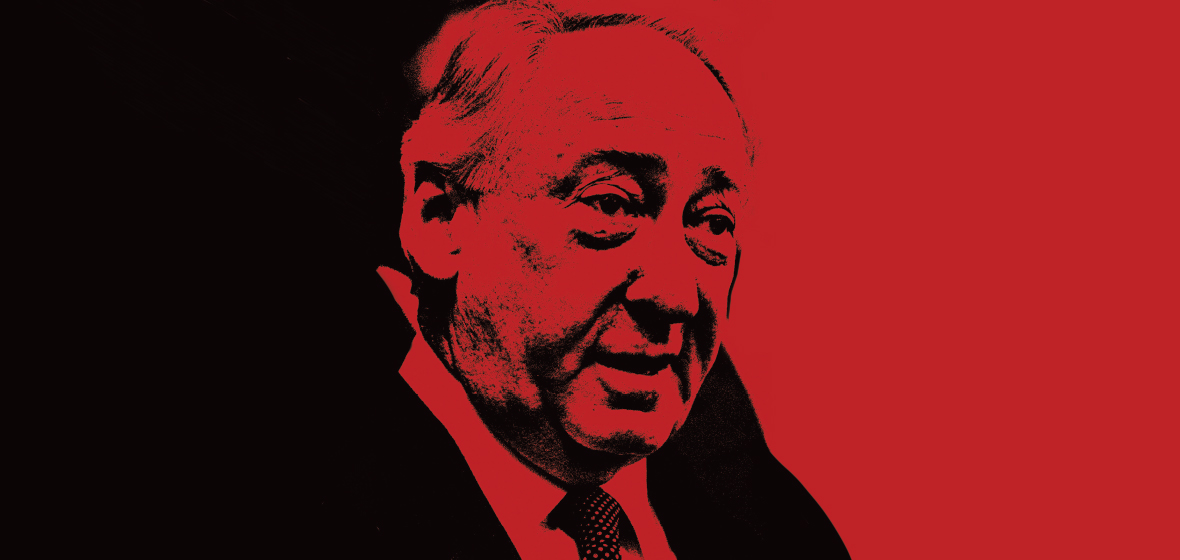The High Court’s third most senior judge, the NSW Chief Magistrate, two District Court judges, the Chief Judge of the District Court, the Chief Judge of the Land and Environment Court, and the Governor-General – the case of High Court judge and Labor hero Lionel Murphy has it all, including his tragic death from cancer just an hour after he handed down his final judgments. Thirty years since the biggest scandal in Australian legal history, the trials of Murphy offer many lessons, writes retired judge STEPHEN WALMSLEY SC.
When judges are appointed to the High Court of Australia, most Australians have never heard of them, but the appointments are rarely controversial.
When Justice Lionel Murphy was appointed to the High Court on 14 February 1975, however, he was one of the best known politicians in the country. He was by no means the first politician appointed to the court, but of those who had been politicians, even including Sir Garfield Barwick, he was probably the most controversial.
The legal profession appreciates more than most the importance of having highly competent and uncontroversial judges, especially on the High Court. Although the legal profession is usually warm in its celebration of High Court appointments, it was less than wholehearted in its welcome for Murphy. The Victorian Bar’s welcome came after a rare internal debate about whether he should be welcomed.
Justice Murphy served on the High Court for 10 years and eight months, dying from cancer on 21 October 1986, just an hour after his last judgments were delivered. For two-thirds of his time as a High Court judge he was involved personally in litigation concerning allegations about his personal conduct. For the last 22 months of his life, he sat for only three days.
The first four years he was a High Court judge, Murphy, along with former Prime Minister Gough Whitlam and former Whitlam Government ministers Rex Connor and Jim Cairns, was forced to fight allegations that they had committed criminal conspiracies to avoid compliance with Commonwealth laws concerning the raising of money by the Commonwealth. This was the private prosecution laid by Sydney solicitor Danny Sankey, which arose from the loans affair (see Sankey v Whitlam (1978) 142 Commonwealth Law Reports 1).
Sankey’s private prosecution did not stop Murphy from sitting as a judge, but he was required to attend court when his committal proceedings were heard at the Court of Petty Sessions in Queanbeyan. The Sankey prosecution was launched on 20 November 1975, just nine days after the dismissal of the Whitlam Government. But it was not until early in 1979 when the Queanbeyan magistrate hearing the case, Darcy Leo, found that none of the accused had a case to answer, and the case against them was dismissed.
By 1983, Murphy was the country’s third most senior judge. In February 1984, The Age published what purported to be transcripts of phone calls illegally recorded by NSW police. The Age tapes, as they became known, contained salacious discussions in which a judge apparently bragged to a solicitor friend about some sexual and drinking exploits. Neither was named but it was soon publicly known that Murphy was the judge.
As it turned out, The Age had made a serious mistake, accidentally swapping around the parties to the conversation, incorrectly attributing to Murphy what had been said by the solicitor, and vice versa. The Age apologised but the apology was neither early nor handsome.
Other purported transcripts of Murphy’s conversations published by The Age, without the transposition errors, did not obviously disclose criminal conduct, but did not reflect well on Murphy’s character. There was no evidence the recordings were genuine, but the Hawke Labor Government came under pressure to take action to protect the High Court’s standing.
The steps Hawke took did not satisfy Murphy’s critics, and the Senate, which Labor did not control, set up the first of what proved to be two Senate inquiries into the Labor hero.
The story behind my book, The Trials of Justice Murphy, began with the first of the Senate inquiries. Murphy had been a powerful figure in the Whitlam Government and had a good mix of friends and enemies.
Friends of Murphy, and he still has many, would say the Senate inquiries and subsequent trials would not have taken place had he been uncontroversial or a former conservative politician. Some saw his prosecution as a payback for the prosecution by the Wran Government of Ian Sinclair, the former leader of the National Country Party, who was charged with forgery and acquitted in 1980.

In December 1984, just weeks after the second Senate inquiry, Murphy was charged with attempting to pervert the course of justice. These charges involved what were said to be attempts to lean on a magistrate and a judge to help his friend, solicitor Morgan Ryan, who he called his “little mate”, get off some criminal charges.
There were many remarkable aspects of the affair. First, there was the country’s third most senior judge, a man who sometimes acted as Chief Justice of the High Court, charged with serious criminal offences, which, on conviction, would inevitably result in a lengthy period of imprisonment. It is an uncomfortable thing to consider how it would be today, 30 years later, if one of our High Court judges was charged with such an offence.
Then there were the personalities involved. The allegations against Murphy were made by significant members of the judiciary. The first to speak up was the Chief Magistrate of NSW, Clarrie Briese.
When Briese spoke up, he was mercilessly attacked by Murphy supporters. These supporters were not just any members of the public. One was the then NSW Premier, Neville Wran QC, who, for much of his term as Premier, was also Minister for Police. Instead of taking the allegations seriously, Wran publicly condemned Briese, calling on him to resign.
Another Murphy supporter, a then journalist from The Bulletin called Malcolm Turnbull, not only attacked Briese, also telling him to resign, but described the first Senate committee as a kangaroo court and attacked its Liberal Party members who had, in their minority finding, found a prima facie case against Murphy.
It turned out that Murphy was not the only judge accused of trying to lean on NSW judicial officers. A District Court judge, John Foord QC, was also accused of trying to help Morgan Ryan by unlawful means. He, like Murphy, was also a friend of Ryan who, like Murphy, also wanted to help him with his troubles. The vicious attacks on the Chief Magistrate by Wran and Turnbull and others led the trial judge in Morgan Ryan’s case, the late Paul Flannery QC, to come forward with allegations Murphy and Foord had tried to nobble him when the trial was proceeding.

Throughout the Murphy affair, the part played by the inaugural Commonwealth Director of Public Prosecutions (DPP), Ian Temby QC, was signi cant. He was appointed by the Hawke government. The office of DPP is independent of government and Temby’s appointment allowed him to make decisions an Attorney-General would have found politically awkward to make. It was he who decided to charge Murphy. For exercising his independent discretion, Temby also was attacked publicly by Wran, who, somewhat hypocritically, called him a media tart, Wran being a well-known media tart himself.
Wran, a QC for decades, was later charged with and convicted of contempt of court for extravagant supportive public comments he made to Daily Telegraph journalists, expressing the strong view that Murphy was innocent. Wran made these remarks just before Murphy’s second jury trial was to begin.
The Daily Telegraph’s publisher was also convicted of contempt of court for publishing Wran’s comments.
In the course of the Murphy Trials, there was evidence Murphy had dropped in to see the Chief Judge of the District Court to ask that his friend Morgan Ryan could have a speedy trial. Although the approach was not illegal, it would be unthinkable today for a High Court judge to make such an approach to any judge of any court. Indeed, I could not imagine any Australian judge today, of any court, at any level, even considering making such an approach for a friend.
I would have thought most of those who appreciated how the legal system worked would have thought it unthinkable in 1982. But Murphy apparently saw this as something he could do because he and the Chief Judge had been friends from the old days at the Bar.
I hasten to point out that when approached, the Chief Judge, James Staunton QC, behaved perfectly appropriately, politely sending Murphy on his way.
Then there was another judge involved in the affair who, when in politics, was known as Diamond Jim McClelland. He was a minister in the second Whitlam Government.
When Murphy went looking for help for Ryan, he also asked McClelland to help him. By this time, McClelland, who had lost his Senate seat in the 1975 election, had become the Chief Judge of the Land and Environment Court of NSW, appointed by the Wran Government.
McClelland gave sworn evidence four times over the two years of the Murphy affair about assistance he gave to Murphy with Ryan’s case.
After McClelland died in early 1999, journalists David Marr and Wendy Bacon revealed that before he died McClelland had confessed to each of them that when giving evidence he had perjured himself to help Murphy win. The details of how McClelland tried to help, his confessions of perjury, and whether he did in fact commit perjury are discussed in my book.
So the Murphy affair involved a very senior High Court judge, the NSW Chief Magistrate, two District Court judges, the Chief Judge of the District Court, and the Chief Judge of the Land and Environment Court.
There was also involvement by the then Governor-General, former High Court Judge Sir Ninian Stephen, who, after Murphy’s ultimate acquittal, was asked by Prime Minister Bob Hawke to advise Murphy to resign. There is no suggestion Sir Ninian did make that request, but judging by Murphy’s response to similar suggestions from then Attorney-General and Senator Gareth Evans, any such suggestions would have fallen on deaf ears.
I have always admired whistle blowers. They are often brave people the establishment does not want to hear from. They are often sacked, demoted or criticised for their roles. They are often women.
NSW has a sorry history of the way it has treated whistle blowers. Those with long memories will recall the NSW police officer, the late Detective Sergeant Philip Arantz, who in 1971 ended up in a mental ward and was later sacked after publicly questioning blatantly incorrect crime clear-up rates heralded by a corrupt police commissioner who was himself supported by a corrupt premier.
The idea for The Trials of Lionel Murphy arose after I met one of the whistle blowers against Murphy, the late Paul Flannery QC, who became my father-in-law.
My meeting with his daughter, Leonie, and my later discussions with his family, especially Paul’s wife, Rosemary, about how the case had invaded and a ected their lives, coupled with the fact Rosemary Flannery had kept 20 boxes of press clippings from the time, gave me the idea for the book.
The other whistle blower, Clarrie Briese, like Paul Flannery, also a very brave man, su ered greatly for doing what he thought was right.
My book describes both Senate inquiries, the committal hearing in the Local Court, the rst trial, the sentencing, the appeal, the second trial, and the Commission of Inquiry set up by the Hawke government to inquire into new allegations. It has a close look at the NSW jury system in action. It contains many observations about criminal trial procedure, which I hope aspiring advocates will value. The Commission of Inquiry was wound up without completing its task when Murphy announced he was dying of cancer. The Parliament decided the public should wait 30 years before having access to the material the commission was examining. That time was up on 24 September last year. Stand by for some interesting revelations.
Do I think High Court Justice Murphy was guilty of attempting to pervert the course of justice? I would prefer readers make up their own minds.





